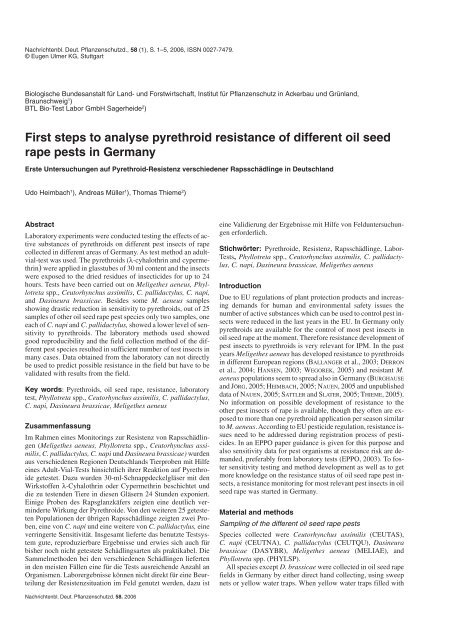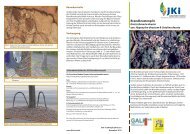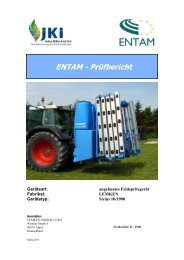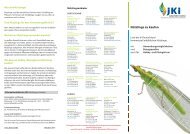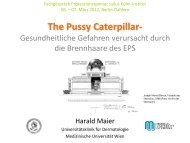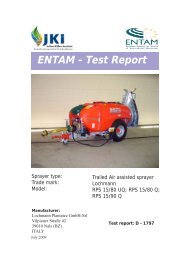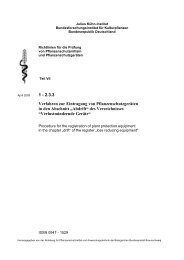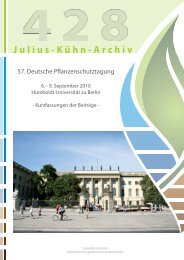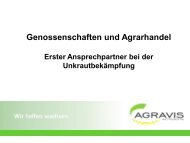First steps to analyse pyrethroid resistance of different oil seed rape ...
First steps to analyse pyrethroid resistance of different oil seed rape ...
First steps to analyse pyrethroid resistance of different oil seed rape ...
You also want an ePaper? Increase the reach of your titles
YUMPU automatically turns print PDFs into web optimized ePapers that Google loves.
Nachrichtenbl. Deut.Pflanzenschutzd., 58 (1), S.1–5, 2006, ISSN 0027-7479.<br />
© Eugen Ulmer KG, Stuttgart<br />
Biologische Bundesanstalt für Land- und Forstwirtschaft, Institut für Pflanzenschutz in Ackerbau und Grünland,<br />
Braunschweig 1 )<br />
BTL Bio-Test Labor GmbH Sagerheide 2 )<br />
<strong>First</strong> <strong>steps</strong> <strong>to</strong> <strong>analyse</strong> <strong>pyrethroid</strong> <strong>resistance</strong> <strong>of</strong> <strong>different</strong> <strong>oil</strong> <strong>seed</strong><br />
<strong>rape</strong> pests in Germany<br />
Erste Untersuchungen auf Pyrethroid-Resistenz verschiedener Rapsschädlinge in Deutschland<br />
Udo Heimbach 1 ), Andreas Müller 1 ), Thomas Thieme 2 )<br />
Abstract<br />
Labora<strong>to</strong>ry experiments were conducted testing the effects <strong>of</strong> active<br />
substances <strong>of</strong> <strong>pyrethroid</strong>s on <strong>different</strong> pest insects <strong>of</strong> <strong>rape</strong><br />
collected in <strong>different</strong> areas <strong>of</strong> Germany. As test method an adultvial-test<br />
was used. The <strong>pyrethroid</strong>s ( λ -cyhalothrin and cypermethrin)<br />
were applied in glasstubes <strong>of</strong> 30 ml content and the insects<br />
were exposed <strong>to</strong> the dried residues <strong>of</strong> insecticides for up <strong>to</strong> 24<br />
hours. Tests have been carried out on Meligethes aeneus, Phyllotreta<br />
spp., Ceu<strong>to</strong>rhynchus assimilis , C. pallidactylus, C. napi,<br />
and Dasineura brassicae . Besides some M. aeneus samples<br />
showing drastic reduction in sensitivity <strong>to</strong> <strong>pyrethroid</strong>s, out <strong>of</strong> 25<br />
samples <strong>of</strong> other <strong>oil</strong> <strong>seed</strong> <strong>rape</strong> pest species only two samples, one<br />
each <strong>of</strong> C. napi and C. pallidactylus, showed a lower level <strong>of</strong> sensitivity<br />
<strong>to</strong> <strong>pyrethroid</strong>s. The labora<strong>to</strong>ry methods used showed<br />
good reproducibility and the field collection method <strong>of</strong> the <strong>different</strong><br />
pest species resulted in sufficient number <strong>of</strong> test insects in<br />
many cases. Data obtained from the labora<strong>to</strong>ry can not directly<br />
be used <strong>to</strong> predict possible <strong>resistance</strong> in the field but have <strong>to</strong> be<br />
validated with results from the field.<br />
Key words : Pyrethroids, <strong>oil</strong> <strong>seed</strong> <strong>rape</strong>, <strong>resistance</strong>, labora<strong>to</strong>ry<br />
test, Phyllotreta spp., Ceu<strong>to</strong>rhynchus assimilis, C. pallidactylus,<br />
C. napi, Dasineura brassicae, Meligethes aeneus<br />
Zusammenfassung<br />
Im Rahmen eines Moni<strong>to</strong>rings zur Resistenz von Rapsschädlingen<br />
( Meligethes aeneus, Phyllotreta spp., Ceu<strong>to</strong>rhynchus assimilis<br />
, C. pallidactylus, C. napi und Dasineura brassicae) wurden<br />
aus verschiedenen Regionen Deutschlands Tierproben mit Hilfe<br />
eines Adult-Vial-Tests hinsichtlich ihrer Reaktion auf Pyrethroide<br />
getestet. Dazu wurden 30-ml-Schnappdeckelgläser mit den<br />
Wirks<strong>to</strong>ffen λ -Cyhalothrin oder Cypermethrin beschichtet und<br />
die zu testenden Tiere in diesen Gläsern 24 Stunden exponiert.<br />
Einige Proben des Rapsglanzkäfers zeigten eine deutlich verminderte<br />
Wirkung der Pyrethroide. Von den weiteren 25 getesteten<br />
Populationen der übrigen Rapsschädlinge zeigten zwei Proben,<br />
eine von C. napi und eine weitere von C. pallidactylus, eine<br />
verringerte Sensitivität. Insgesamt lieferte das benutzte Testsystem<br />
gute, reproduzierbare Ergebnisse und erwies sich auch für<br />
bisher noch nicht getestete Schädlingsarten als praktikabel. Die<br />
Sammelmethoden bei den verschiedenen Schädlingen lieferten<br />
in den meisten Fällen eine für die Tests ausreichende Anzahl an<br />
Organismen. Laborergebnisse können nicht direkt für eine Beurteilung<br />
der Resistenzsituation im Feld genutzt werden, dazu ist<br />
Nachrichtenbl. Deut.Pflanzenschutzd. 58. 2006<br />
eine Validierung der Ergebnisse mit Hilfe von Felduntersuchungen<br />
erforderlich.<br />
Stichwörter: Pyrethroide, Resistenz, Rapsschädlinge, Labor-<br />
Tests, Phyllotreta spp., Ceu<strong>to</strong>rhynchus assimilis, C. pallidactylus,<br />
C. napi, Dasineura brassicae, Meligethes aeneus<br />
Introduction<br />
Due <strong>to</strong> EU regulations <strong>of</strong> plant protection products and increasing<br />
demands for human and environmental safety issues the<br />
number <strong>of</strong> active substances which can be used <strong>to</strong> control pest insects<br />
were reduced in the last years in the EU. In Germany only<br />
<strong>pyrethroid</strong>s are available for the control <strong>of</strong> most pest insects in<br />
<strong>oil</strong> <strong>seed</strong> <strong>rape</strong> at the moment. Therefore <strong>resistance</strong> development <strong>of</strong><br />
pest insects <strong>to</strong> <strong>pyrethroid</strong>s is very relevant for IPM. In the past<br />
years Meligethes aeneus has developed <strong>resistance</strong> <strong>to</strong> <strong>pyrethroid</strong>s<br />
in <strong>different</strong> European regions (B ALLANGER et al., 2003; D ERRON<br />
et al., 2004; H ANSEN, 2003; W EGOREK, 2005) and resistant M.<br />
aeneus populations seem <strong>to</strong> spread also in Germany (B URGHAUSE<br />
and J ÖRG, 2005; H EIMBACH, 2005; N AUEN, 2005 and unpublished<br />
data <strong>of</strong> N AUEN, 2005; S ATTLER and S LATER, 2005; T HIEME, 2005).<br />
No information on possible development <strong>of</strong> <strong>resistance</strong> <strong>to</strong> the<br />
other pest insects <strong>of</strong> <strong>rape</strong> is available, though they <strong>of</strong>ten are exposed<br />
<strong>to</strong> more than one <strong>pyrethroid</strong> application per season similar<br />
<strong>to</strong> M. aeneus. According <strong>to</strong> EU pesticide regulation, <strong>resistance</strong> issues<br />
need <strong>to</strong> be addressed during registration process <strong>of</strong> pesticides.<br />
In an EPPO paper guidance is given for this purpose and<br />
also sensitivity data for pest organisms at <strong>resistance</strong> risk are demanded,<br />
preferably from labora<strong>to</strong>ry tests (EPPO, 2003). To foster<br />
sensitivity testing and method development as well as <strong>to</strong> get<br />
more knowledge on the <strong>resistance</strong> status <strong>of</strong> <strong>oil</strong> <strong>seed</strong> <strong>rape</strong> pest insects,<br />
a <strong>resistance</strong> moni<strong>to</strong>ring for most relevant pest insects in <strong>oil</strong><br />
<strong>seed</strong> <strong>rape</strong> was started in Germany.<br />
Material and methods<br />
Sampling <strong>of</strong> the <strong>different</strong> <strong>oil</strong> <strong>seed</strong> <strong>rape</strong> pests<br />
Species collected were Ceu<strong>to</strong>rhynchus assimilis (CEUTAS),<br />
C. napi (CEUTNA), C. pallidactylus (CEUTQU), Dasineura<br />
brassicae (DASYBR), Meligethes aeneus (MELIAE), and<br />
Phyllotreta spp. (PHYLSP).<br />
All species except D. brassicae were collected in <strong>oil</strong> <strong>seed</strong> <strong>rape</strong><br />
fields in Germany by either direct hand collecting, using sweep<br />
nets or yellow water traps. When yellow water traps filled with
2 U DO H EIMBACH et al, <strong>First</strong> <strong>steps</strong> <strong>to</strong> <strong>analyse</strong> <strong>pyrethroid</strong> <strong>resistance</strong> <strong>of</strong> <strong>different</strong> <strong>oil</strong> <strong>seed</strong> <strong>rape</strong> pests in Germany<br />
Figure 1. Areas <strong>of</strong> collection <strong>of</strong> <strong>oil</strong> <strong>seed</strong> <strong>rape</strong> pest insects in Germany.<br />
water were used, they had <strong>to</strong> be empty several times a day <strong>to</strong><br />
avoid harming the collected beetles. Collected animals were<br />
transported and s<strong>to</strong>red in boxes with some <strong>oil</strong> <strong>seed</strong> <strong>rape</strong> leaves as<br />
food. The boxes had an inlet <strong>of</strong> paper <strong>to</strong> avoid the building <strong>of</strong><br />
condense water. S<strong>to</strong>ring <strong>of</strong> the insects <strong>to</strong>ok place at low temperatures<br />
<strong>of</strong> about 10 °C.<br />
For the collection <strong>of</strong> D. brassicae infested pods <strong>of</strong> <strong>oil</strong> <strong>seed</strong> <strong>rape</strong><br />
were collected and kept in hatching cages in the labora<strong>to</strong>ry. Larvae<br />
leaving the pods pupated in a small amount <strong>of</strong> s<strong>oil</strong> supplied<br />
below the pods. Midges hatching were kept only for up <strong>to</strong> 3 days<br />
at low temperature and high humidity before they were used in<br />
the tests. No food was supplied.<br />
All insects which were not collected by the BBA were mailed<br />
<strong>to</strong> Braunschweig for the tests. Most samples arrived in good conditions<br />
in Braunschweig. Only 4 out <strong>of</strong> 38 samples could not be<br />
used for tests anymore, because the insects did not survive the<br />
transport. In 6 out <strong>of</strong> a <strong>to</strong>tal <strong>of</strong> 12 samples <strong>of</strong> D. brassicae no or<br />
not enough midges hatched.<br />
Sampling <strong>of</strong> test insects<br />
The samples collected and tested are presented in Table 1. Figure<br />
1 illustrates the locations <strong>of</strong> the sampling in Germany. In some<br />
cases M. aeneus samples were collected in areas with known <strong>resistance</strong><br />
shown by reduced field effects after application (samples<br />
No. 9, 19, 25, 34, 43).<br />
Insecticide tests in the labora<strong>to</strong>ry, adult-vial-test<br />
Similar <strong>to</strong> an unpublished method used by T HIEME in his labora<strong>to</strong>ry,<br />
glass vials <strong>of</strong> 30 ml content (6.5 cm long and 2.4 cm diameter)<br />
were used for the test. Prior <strong>to</strong> testing the vials were coated<br />
with the active substance <strong>of</strong> <strong>pyrethroid</strong>s dissolved in ace<strong>to</strong>ne in<br />
<strong>different</strong> concentrations. 1.3 ml <strong>of</strong> the solution was given in<strong>to</strong><br />
each vial. The vials were kept open on a rolling bank for about<br />
90 minutes until the ace<strong>to</strong>ne was evaporated, resulting in an even<br />
film <strong>of</strong> the active substance on the walls and bot<strong>to</strong>m <strong>of</strong> the glass<br />
vials. In trials with the formulated product Karate Zeon ® water<br />
was used as solvent. Drying <strong>of</strong> the vials on the rolling bank with<br />
Table 1. Test number,date <strong>of</strong> collection,collec<strong>to</strong>r,and number <strong>of</strong> insects tested at a rate <strong>of</strong> 0.015 µg/cm² λ -cyhalothrin<br />
Sample Date <strong>of</strong> Institution Collec<strong>to</strong>r Species No. tested at<br />
Number collection (EPPO Code) 0.015 µg/cm²<br />
λ -cyhalothrin<br />
1 20.03.05 Univ.<strong>of</strong> Göttingen Ulber/Wedemeyer CEUTNA 50 in 5 repl.<br />
2 24. 03.05 BBA Braunschweig Müller CEUTNA 18 in 2 repl.<br />
3 24. 03.05 BBA Braunschweig Müller CEUTQU 15 in 3 repl.<br />
4 24. 03.05 LWA Coburg Hemmer CEUTQU 30 in 5 repl.<br />
5 24. 03.05 Spiess-Urania Goebel CEUTQU 20 in 4 repl.<br />
7 04. 04. 05 BBA Braunschweig Müller CEUTQU 8 in 1 repl.<br />
8 04. 04. 05 DLR Rheinhessen Burghause PHYLSP 38 in 4 repl.<br />
9 04. 04. 05 DLR Rheinhessen Burghause MELIAE 30 in 3 repl.<br />
10 04. 04. 05 LWA Deggendorf Thalhammer CEUTQU 40 in 4 repl.<br />
12 04. 04. 05 LWA Regensburg Rupprecht CEUTQU 30 in 3 repl<br />
13 04.04.05 LWA Regensburg Rupprecht CEUTNA 10 in 1 repl.<br />
16 08. 04. 05 LWA Leinefelde Eiselt CEUTQU 20 in 2 repl.<br />
18 13.04. 05 BASF Limburgerh<strong>of</strong> Landvogt CEUTQU 10 in 1 repl.<br />
19 06.04. 05 BTL Bio-Test Labor Thieme MELIAE 10 in 1 repl.<br />
20 14. 04. 05 LWA Würzburg Rüdinger MELIAE 10 in 1 repl.<br />
21 17.04. 05 LWA Würzburg Seifert MELIAE 20 in 2 repl.<br />
22 04. 05. 05 BBA Braunschweig Müller PHYLSP 23 in 2 repl.<br />
25 10.05. 05 DLR Westeifel Schackmann MELIAE 40 in 4 repl.<br />
26 10.05. 05 DLR Westeifel Schackmann PHYLSP 51 in 4 repl.<br />
27 11. 05. 05 Univ.<strong>of</strong> Göttingen Ulber CEUTAS 17 in 2 repl.<br />
28 23.05. 05 BBA Braunschweig Müller PHYLSP 21 in 2 repl.<br />
29 24. 05. 05 BBA Braunschweig Müller MELIAE 42 in 4 repl.<br />
30 25. 05. 05 PSA Oldenburg Schröder MELIAE 37 in 4 repl.<br />
31 25. 05. 05 PSA Oldenburg Schröder CEUTAS 32 in 3 repl.<br />
32 02.05. 05 BTL Bio-Test Labor Bergmann CEUTAS 22 in 2 repl.<br />
33 24. 05. 05 LWA Hildburghausen Hartmann CEUTAS 9 in 1 repl.<br />
34 25. 04. 05 BTL Bio-Test Labor Thieme MELIAE 42 in 4 repl.<br />
35 01. 06.05 PSA Oldenburg Schröder DASYBR 48 in 4 repl.<br />
36 02.06.05 BBA Braunschweig Müller DASYBR 21 in 2 repl.<br />
37 02.06.05 BBA Braunschweig Müller DASYBR 9 in 1 repl.<br />
38 06.06.05 PSA Schwerin Rehm DASYBR 24 in 2 repl.<br />
39 06.06.05 ALR Lübeck Landschreiber DASYBR 51 in 4 repl.<br />
41 05. 06.05 ALR Lübeck Kaak DASYBR 23 in 2 repl.<br />
43 15. 06.05 BTL Bio-Test Labor Thieme MELIAE 36 in 4 repl.<br />
Nachrichtenbl. Deut.Pflanzenschutzd. 58. 2006
Nachrichtenbl. Deut.Pflanzenschutzd. 58. 2006<br />
U DO H EIMBACH et al, <strong>First</strong> <strong>steps</strong> <strong>to</strong> <strong>analyse</strong> <strong>pyrethroid</strong> <strong>resistance</strong> <strong>of</strong> <strong>different</strong> <strong>oil</strong> <strong>seed</strong> <strong>rape</strong> pests in Germany 3<br />
water as solvent lasted up <strong>to</strong> 24 hours. The vials were closed then<br />
with a lid and s<strong>to</strong>red at 8 °C in the dark for up <strong>to</strong> 14 days before<br />
the insects were exposesed in the vials.<br />
As insecticides the active substances <strong>of</strong> lambda-cyhalothrin<br />
and cypermethrin were used and in some <strong>of</strong> the trials additionally<br />
a formulated product with the active substance λ -cyhalothrin<br />
(Karate Zeon ® ) was used. As far as possible, besides a control,<br />
several rates <strong>of</strong> the <strong>pyrethroid</strong>s were tested, depending on the<br />
number <strong>of</strong> insects available. Rates used for λ -cyhalothrin were:<br />
0.075 µg/cm² <strong>of</strong> glass surface which is representing the registered<br />
field rate in Germany <strong>of</strong> 7.5 g a.s./ha. Additionally lower<br />
(down <strong>to</strong> 0.00075 µg/cm²) and higher rates (up <strong>to</strong> 0.75 µg/cm²)<br />
were tested, depending on the number <strong>of</strong> insects available. The<br />
rate <strong>of</strong> 0.015 µg/cm² was chosen <strong>to</strong> distinguish differences in<br />
population sensitivity, because at this rate all samples <strong>of</strong> M.<br />
aeneus with known field <strong>resistance</strong> showed less than 100 % mortality<br />
5 hours after exposure. Cypermethrin was used in rates between<br />
0.003 and 3.0 µg/cm² (0.3 µg/cm² is the equivalent <strong>to</strong> the<br />
field rate <strong>of</strong> 30 g a.s./ha that has been used in Germany in the<br />
past).<br />
Mortality [%]<br />
Mortality [%]<br />
80<br />
60<br />
40<br />
20<br />
0<br />
100<br />
75<br />
50<br />
25<br />
0<br />
MELIAE 43 MELIAE 34<br />
λ-cyhalothrin<br />
Karate Zeon<br />
Samples tested<br />
Insects were kept for at least 1 day in the labora<strong>to</strong>ry before<br />
only those, appearing <strong>to</strong> be unaffected and active, were exposed<br />
<strong>to</strong> the residues. About 10 individuals were exposed per vial<br />
which was closed with a lid, having a small prick for ventilation.<br />
If possible up <strong>to</strong> 5 replications were carried out per test rate. The<br />
vials with the exposed insects were kept at a constant temperature<br />
<strong>of</strong> 16°C and at constant light. Assessments were carried out<br />
after 1, 5, and 24 hours. Assessments after 5 hours were chosen<br />
<strong>to</strong> be reported, because control mortality <strong>of</strong>ten was increased at<br />
24 hours already, whereas a significant increase <strong>of</strong> effects was<br />
detected between 1 and 5 hours and only a small increase any<br />
more between 5 and 24 hours, which is the expectation for the<br />
fast acting <strong>pyrethroid</strong>s. All results presented were not corrected<br />
for control mortality values.<br />
Results and discussion<br />
Two samples <strong>of</strong> M. aeneus were taken, <strong>to</strong> test whether the use <strong>of</strong><br />
the active substance and the formulated product on the glass surface<br />
<strong>of</strong> the vials may result in <strong>different</strong> effects using the adult-<br />
λ-cyhalothrin 0.015 Mg a.s./cm²<br />
Karate Zeon 0.015 Mg a.s./cm²<br />
0.0 0.0015 0.00375 0.015 0.075 0.75<br />
λ-cyhalothrin rate [Eg a.s./cm²]<br />
Figure 2.Mean mortality ( ± SD) <strong>of</strong><br />
two M.aeneus samples with the formulated<br />
product Karate Zeon and<br />
the active substance λ -cyhalothrin<br />
using the same rate <strong>of</strong> a.s. <strong>of</strong> 0.015<br />
µg/cm². (For the number <strong>of</strong> insects<br />
used per test see Tab.1).<br />
Figure 3.Mean mortality ( ± SD) <strong>of</strong> a<br />
M. aeneus sample (no. 34) in adultvial-tests<br />
after an exposure <strong>of</strong> 5<br />
hours with the formulated product<br />
Karate Zeon and the active substance<br />
λ -cyhalothrin using <strong>different</strong><br />
rates. (For the number <strong>of</strong> insects<br />
used per test see Tab.1).
4 U DO H EIMBACH et al, <strong>First</strong> <strong>steps</strong> <strong>to</strong> <strong>analyse</strong> <strong>pyrethroid</strong> <strong>resistance</strong> <strong>of</strong> <strong>different</strong> <strong>oil</strong> <strong>seed</strong> <strong>rape</strong> pests in Germany<br />
Figure 4. Mean mortality ( ± SD) <strong>of</strong><br />
several M.aeneus samples in adultvial-tests<br />
after an exposure <strong>of</strong> 5<br />
hours with λ -cyhalothrin using the<br />
same rate <strong>of</strong> a.s. <strong>of</strong> 0.015 µg/cm².<br />
(For the number <strong>of</strong> insects used per<br />
test see Tab.1).<br />
vial-test design. The results were quite similar in two experiments<br />
thus showing that no major difference was detected between<br />
the use <strong>of</strong> the active substance λ -cyhalothrin and the formulated<br />
product Karate Zeon in the test system (Fig. 2). This is<br />
supported by comparing the effects <strong>of</strong> the active substance and<br />
the product for several rates <strong>of</strong> λ -cyhalothrin and Karate Zeon on<br />
a sample <strong>of</strong> M. aeneus with known <strong>resistance</strong> in the field. For<br />
each test rates similar mortality values were obtained between effects<br />
<strong>of</strong> the active substance and the product (Fig. 3). Even at the<br />
highest test rate (equivalent <strong>to</strong> 10 times the field rate) no full control<br />
<strong>of</strong> M. aeneu s was achieved which was also the case for the<br />
samples 19, 25, 43.<br />
The effects <strong>of</strong> λ -cyhalothrin at a rate <strong>of</strong> 0.015 µg/cm² clearly<br />
show differences between the nine samples <strong>of</strong> M. aeneus tested.<br />
The samples originating from regions or fields with known<br />
<strong>pyrethroid</strong> <strong>resistance</strong> react <strong>different</strong>ly from areas where no <strong>resistance</strong><br />
is known yet. This differences at a rate <strong>of</strong> 0.015 µg/cm²<br />
seem <strong>to</strong> allow <strong>to</strong> separate between populations being still sensitive<br />
compared <strong>to</strong> those with detectable reduction <strong>of</strong> efficacy in<br />
Figure 5. Mean mortality ( ± SD) <strong>of</strong><br />
<strong>different</strong> <strong>oil</strong> <strong>seed</strong> <strong>rape</strong> pest insects in<br />
adult-vial-tests after an exposure <strong>of</strong><br />
5 hours with the 2 active substances<br />
cypermethrin (0.06 µg/cm²) and λ -<br />
cyhalothrin (0.015 µg/cm²). (For the<br />
number <strong>of</strong> insects used per test see<br />
Tab.1).<br />
Mortality [%]<br />
Mortality [%]<br />
100<br />
100<br />
75<br />
50<br />
25<br />
75<br />
50<br />
25<br />
0<br />
0<br />
control<br />
λ-cyhalothrin 0.015 Fg/cm²<br />
19 34 25 43 9 21 30 29 20<br />
Samples <strong>of</strong> M. aeneus<br />
the field (Fig. 4). Control mortality in most cases was equal or<br />
below 10% in tests, which was also the case for the other beetles<br />
species (average control mortality <strong>of</strong> 1.86% after 5 hours in 28<br />
tests) but higher for D. brassicae (average <strong>of</strong> 11.95 % after 5<br />
hours in 6 tests). After 24 hours the mean control mortality was<br />
11.98 % for beetles and 30.67 % for midges.<br />
Five samples <strong>of</strong> <strong>different</strong> pest species were tested comparing<br />
the active substances <strong>of</strong> cypermethrin and λ -cyhalothrin at rates<br />
<strong>of</strong> 0.06 µg/cm² <strong>of</strong> cypermethrin and 0.015 µg/cm² <strong>of</strong> λ -cyhalothrin.<br />
Results were similar in all tests (Fig. 5). This is indicating<br />
that the two M. aeneus samples show cross <strong>resistance</strong> <strong>to</strong><br />
this <strong>pyrethroid</strong>s.<br />
Comparing the results <strong>of</strong> all samples tested (Fig. 6) it is obvious<br />
that a main <strong>resistance</strong> problem seems <strong>to</strong> exist with M. aeneus<br />
only. But it has <strong>to</strong> be kept in mind, that sampling was not randomly,<br />
but more concentrated in areas with known <strong>resistance</strong> for<br />
M. aeneus, whereas for the other species tested, sampling was<br />
carried out mainly in regions where no <strong>resistance</strong> is known yet.<br />
Especially from northern Germany, the region with most<br />
MELIAE 25 MELIAE 43 CEUTNA 1 CEUTQU 10 DASYBR 35<br />
Samples tested<br />
cypermethrin 0.06 Sg/cm²<br />
λ-cyhalothrin 0.015 Sg/cm²<br />
Nachrichtenbl. Deut.Pflanzenschutzd. 58. 2006
Mortality [%]<br />
100<br />
75<br />
50<br />
25<br />
0<br />
Nachrichtenbl. Deut.Pflanzenschutzd. 58. 2006<br />
U DO H EIMBACH et al, <strong>First</strong> <strong>steps</strong> <strong>to</strong> <strong>analyse</strong> <strong>pyrethroid</strong> <strong>resistance</strong> <strong>of</strong> <strong>different</strong> <strong>oil</strong> <strong>seed</strong> <strong>rape</strong> pests in Germany 5<br />
<strong>pyrethroid</strong> <strong>resistance</strong> problems, only few pest insects samples<br />
except M. aeneus could be tested, because <strong>of</strong> low pest density in<br />
2005 in this region.<br />
Results <strong>of</strong> two samples <strong>of</strong> stem weevils (No. 13 and 16) indicate<br />
that there might be a rising problem with this species in some<br />
areas. But <strong>to</strong> be sure if there is <strong>resistance</strong> developing or not, generally<br />
labora<strong>to</strong>ry data need <strong>to</strong> be validated with real field data.<br />
More <strong>analyse</strong>s must be carried out for the other <strong>oil</strong> <strong>seed</strong> <strong>rape</strong><br />
pests <strong>to</strong> find out if relevant sensitivity changes are developing<br />
which might finally end in field <strong>resistance</strong>.<br />
It also has <strong>to</strong> be kept in mind, that all tests were carried out<br />
on small numbers <strong>of</strong> populations <strong>of</strong> <strong>different</strong> insect species<br />
and therefore it is not possible <strong>to</strong> show first signs <strong>of</strong> <strong>resistance</strong><br />
unless very high numbers are tested. The results only can give<br />
a rough indication <strong>of</strong> the percentage <strong>of</strong> individuals with <strong>resistance</strong>.<br />
Conclusions<br />
MELIAE CEUTNA CEUTQU CEUTAS PHYESP DASYBR<br />
34 19 25 43 9 21 30 20 29 1 2 13 10 7 4 5 3 12 18 16 27 31 33 32 28 26 22 8 35 39 38 41 37 36<br />
Samples tested<br />
EPPO defines <strong>resistance</strong> as a clear reduction <strong>of</strong> effectiveness in<br />
the field at the registered rate <strong>of</strong> a plant protection product compared<br />
<strong>to</strong> field effectiveness reached in the past. Field failure alone<br />
can not answer the question if there is <strong>resistance</strong> in a population<br />
<strong>of</strong> insects or not, because several fac<strong>to</strong>rs can result in failure <strong>of</strong><br />
an application <strong>of</strong> insecticides such as reinvasion <strong>of</strong> pest insects,<br />
unfavourable conditions during or after application etc.<br />
Field tests are also <strong>to</strong>o time consuming and expensive <strong>to</strong> screen<br />
for <strong>resistance</strong>. Therefore adequate and standardised labora<strong>to</strong>ry<br />
tests should be developed which are validated by field experiences<br />
and then easily can be used in cases <strong>of</strong> field failure <strong>of</strong> a<br />
product <strong>to</strong> decide if <strong>resistance</strong> or something else caused the problem.<br />
Sensitivity data as demonstrated in this paper can support<br />
the decision if there is <strong>resistance</strong> in a population <strong>of</strong> insects or not.<br />
Distinct differences in the results <strong>of</strong> labora<strong>to</strong>ry tests between <strong>different</strong><br />
populations from <strong>different</strong> regions or years indicate a possible<br />
<strong>resistance</strong>.<br />
The method presented here seems <strong>to</strong> be able <strong>to</strong> <strong>analyse</strong> rising<br />
and already existing <strong>resistance</strong> problems with <strong>pyrethroid</strong>s in <strong>oil</strong><br />
<strong>seed</strong> <strong>rape</strong>. But the method can not be used for all other types <strong>of</strong><br />
products (e.g. not for those that have systemic action, that are act-<br />
ing slowly or that have high volatility). It also needs <strong>to</strong> be<br />
checked carefully, if other pest insects (e.g. aphids probably not)<br />
can be tested in this way.<br />
Acknowledgements<br />
We thank all collec<strong>to</strong>rs <strong>of</strong> samples (see Table 1) for supporting<br />
the moni<strong>to</strong>ring, the UFOP for a financial contribution, and the<br />
companies BASF and Syngenta for supply <strong>of</strong> the active substances.<br />
References<br />
B ALLANGER, Y., D. D ETOURNE, R. D ELORME, X. P INOCHET, 2003: Difficulties<br />
<strong>to</strong> control pollen beetle ( Meligethes aeneus F.) in France revealed<br />
by unusual high level infestations in winter <strong>rape</strong> fields – GCIRC, 11th<br />
International Rape<strong>seed</strong> Congress, Copenhagen, 6-10 July 2003, 3, 1048–<br />
1050.<br />
B URGHAUSE, F., E. J ÖRG, 2005: Bald keine Wirkung mehr? DLG Mitteilungen<br />
H. 4, 40–44.<br />
EPPO 2003: EPPO/OEPP-Standard PP1/213 (2), Resistance Risk Analysis.<br />
EPPO Bulletin 33, 37–63.<br />
D ERRON, J. O., E. L E C LECH, N. B EZENÇON, G. G OY, 2004: Résistance des<br />
méligèthes du colza aux pyréthrinoïdes dans les bassin lémanique. Revue<br />
Suisse Agriculture 36, 237–242.<br />
H ANSEN, L. M., 2003: Insecticide-resistant pollen beetles ( Meligethes<br />
aeneus F) found in Danish <strong>oil</strong><strong>seed</strong> <strong>rape</strong> ( Brassica napus L) fields. Pesticide<br />
Management Science 59, 1057–1059.<br />
H EIMBACH, U., 2005: „Ausschuss für Resistenzfragen – Insektizide und<br />
Akarizide“, Bericht über das erste Treffen im Februar 2005 in der BBA<br />
in Braunschweig. Nachrichtenbl. Deut. Pflanzenschutzd. 57 (8), 172–<br />
173.<br />
N AUEN, R., 2005: Insecticide <strong>resistance</strong> in European agriculture: Research<br />
instead <strong>of</strong> rumours. Proceedings BCPC, Crop Science and Technology,<br />
3A-1, 123–130.<br />
W EGOREK, P., 2005: Preliminary data on <strong>resistance</strong> appearance <strong>of</strong> Pollen<br />
Beetle PB ( Meligethes aeneus F.) <strong>to</strong> selected <strong>pyrethroid</strong>s, organophosphorous<br />
and chloronicotynyls insecticide, in 2004 year in Poland. Resistant<br />
Pest Management Newsletter 14, No. 2: 19–21.<br />
Accepted: Oc<strong>to</strong>ber 2005<br />
Figure 6.Mean mortality ( ± SD) <strong>of</strong><br />
moni<strong>to</strong>red <strong>oil</strong> <strong>seed</strong> <strong>rape</strong> pest insect<br />
samples in adult-vial-tests after an<br />
exposure <strong>of</strong> 5 hours and 0.015<br />
µg/cm² λ -cyhalothrin. Species tested<br />
were: Meligethes aeneus (MELIAE),<br />
C. napi (CEUTNA), C. pallidactylus<br />
(CEUTQU) , Ceu<strong>to</strong>rhynchus assimilis<br />
(CEUTAS), Phyllotreta spp.<br />
(PHYLSP), Dasineura brassicae<br />
(DASYBR). (For the number <strong>of</strong> insects<br />
used per test see Tab.1).<br />
Contact address: Dr. U DO H EIMBACH, Federal Biological Research Centre<br />
for Agriculture and Forestry, Institute for Plant Protection in Arable<br />
Crops and Grassland, Messeweg 11/12, 38104 Braunschweig, Germany,<br />
e-mail: U.Heimbach@bba.de


